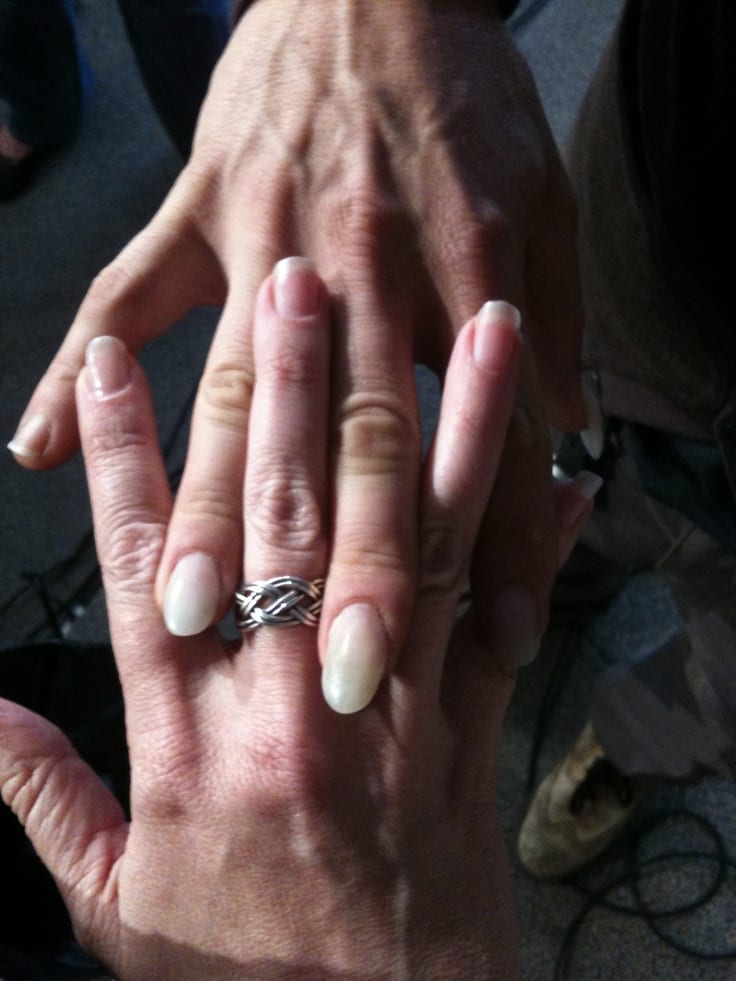How to use the major scale
So, once we’ve gotten the hang of the major scale, we need to know how to use it.
Unlike the pentatonic scale, we can’t just pick any chord from the song’s chord sequence and match up the scale. We need to figure out the song’s actual key.

One of the best free guitar lessons you can learn is how to work out a song’s key. The easiest way is to just look at the first chord of the song.
But this doesn’t always work. Here’s a cool backup plan…
The quick way to do this is to figure out which major chord is the “odd one out”.
Take this sequence:
G | C | D | |
Note how C and D are alphabetically next to each other? This makes G the odd one out, therefore we can use the G major scale to improvise against this chord sequence.

Take this sequence:
E | D | A | |
Here, the D and the E are alphabetically next to each other, so A is the odd one out, so we need the A major scale.
Get the idea?
The chord that’s on its own is the “key chord”.
NB: This only works with major chords. Minor chords work differently. (This article is helpful reading in this area.)
Download our lead guitar cheat-sheet to make things easier
It's hard to understand which scales work with which keys.
So we created a cheat-sheet! A key and scale-finder that you can use again and again.

Get your personalised guitar-learning plan 🎸
Get a custom guitar-learning plan here: Click here for GuitarMetrics™
World-Class Guitar Courses 🌎
Learn from the world's best guitar educators: Click here for our guitar courses
Improvising with the major scale
When you start improvising with the major scale you’ll notice it sounds a bit different to pentatonic improvisation. That’s because there are more notes.
It may only be two more notes, but they can make a lot of difference!
One of the best types of free guitar lessons you can get try are backing tracks. Try playing around G major scale over this backing track:
Free guitar lessons #3 – Fingerpicking
In our opinion, all guitarists should have a go at finger-picking.
Playing with a pick is all very well, but we’re missing out on a lot of cool guitar playing if we don’t learn to use our fingers as well.
Of all the free guitar lessons you can find online, not many cover fingerpicking.
It’s a good job Metallica wrote ‘Nothing Else Matters’, because without it, convincing devout metal guitarists that it’s a good idea to learn fingerpicking would be a serious uphill struggle!
Want free guitar tips and video lessons delivered to your inbox?
Join over 250,000 guitar learners and subscribe to our guitar-tips-by-email service. (It's free.)
We'll send you a series of lessons that will move you to the next level of your guitar journey.
Learn how everything fits together quickly, easily and effectively. We share ninja tips (for instant fun!) but also timeless fundamentals that will deepen your understanding.

Our Guitar Courses
To become a better guitarist click here to see our guitar courses
Get your personalised guitar-learning plan 🎸
Want us to make a guitar-learning plan that is customised to you? Click here for GuitarMetrics™
Advantages of fingerpicking
One of the advantages of fingerpicking is whereas with a pick we only have one thing to hit the strings with, with fingerpicking we have several. This allows us to play certain phrases that simply aren’t doable with a pick.
To fingerpick we want to use our thumb (p), our index finger (i), our middle finger (m) and our ring finger (a). Some people also use the little finger, but for the purpose of these free guitar lessons we’re just going to use those four.
This first exercise will sound a bit classical. It uses only open strings, so we can just concentrate on what our picking hand is doing.
When we fingerpick, it’s important to keep the heel of the hand on the bridge and use the joints of the fingers to power our picking. You don’t want to be flailing your arm around a la Pete Townsend or you’ll find yourself hitting the wrong strings a lot and will struggle to play in time.
This next exercise is a bit more contemporary and rhythmic.
Instead of plucking one string at a time, we’re plucking the bass note with our thumb and then the three highest strings all at once.
We hear this sort of picking in styles like folk, country and blues… but it’s by no means limited to those styles.
Once you’ve got used to playing these exercises with the open strings, why not try them with some chords?
Don’t forget your thumb
Just remember that your thumb needs to pluck the lowest note of the chord, which isn’t always the low E string.
If it’s an A chord, the thumb plucks the A string. If it’s a D chord, pluck the D string.
Once you get comfortable with both these styles of fingerpicking, why not have a go at mixing the two together?
Once you get really into fingerpicking you’ll find that you can improvise your own patterns.
Top-tip: If you’re a really dedicated finger picker, you might want to consider growing the finger nails of your picking hand.
Check out these talons John Butler has!
You don’t have to go quite that extreme, but it can improve your sound and give your playing a different feel.
We don’t just give you free guitar lessons, we teach you about personal grooming too! 🙂
Free guitar lessons #4 – Hammer-ons, pull-offs, string bending and tapping.
For the last of our free guitar lessons, we’re going to look at some cool techniques that can really take our playing to the next level.
If you’ve been improvising for a while, you might crave some new variety. You also may be looking at learning songs that use some of these techniques so let’s just into the last of these free guitar lessons.
Using hammer-ons for fun & feel
Hammer-ons are pretty much exactly what they sound like. They’re when we hammer our finger onto a note to make it sound, instead of plucking it.
A good way to get started with these is to use the basic E minor pentatonic scale in the open position.
We want to pick the open notes and hammer-on the fretted notes.
Check out the video below to see this in action.
Pull-offs are the opposite of hammer-ons
Pull-offs are basically the opposite of hammer-ons. Instead of hammering our finger tip onto a note, we’re pulling it off a note to another note.
(This is one of those cool free guitar lessons that you can actually apply all the time.)
- We can use them to go back down the E minor pentatonic scale.
- We want to pick the fretted notes and pull-off to the open notes.
Here’s a video demonstration of hammering on and pulling off with the E minor pentatonic scale.
So why might we want to use hammer-ons and pull-offs?
Well, for one thing they give us a slightly smoother more flowing sound than all plucked notes (this is called ‘legato’).
They also allow us to play a little bit faster because we aren’t having to rush around with our plectrum, picking every single note.
If you try rapidly hammering on and pulling off between two notes, this is called a trill.

String bending for guitar hero status
String bending, like hammer-ons and pull-offs, is exactly what it sounds like: Bending a note so it becomes another note.
Are you familiar with the A blues scale?
If not, here it is.
Let’s take those three notes on the G string.
Now, instead of playing that 8th fret note, let’s bend the 7th fret note up to that pitch.
This is what that phrase looks like in tab.
If you’re struggling to bend the string, use more fingers to help push. Remember, we only want to bend up to the pitch of the next fret, so don’t bend too hard.
Just adding this one technique to a blues improvisation can make it sound a lot cooler.
Try jamming with this backing track once you get the hang of it.
String tapping
Tapping is a technique that’s been around for a long time. Classical players used and still use it, but it was Eddie Van Halen who brought it to the attention of rock guitarists back in 1979 with a short instrumental track called ‘Eruption’.
Basically, tapping is like hammering on, except we use a finger from the picking hand instead of the fretting hand.
If that sounds a bit confusing, try watching it in action:
Tapping, when combined with hammer-ons and pull-offs can create a very fluid sound, so much so that when people first heard Eddie Van Halen play ‘Eruption’, many were convinced they were hearing a synthesiser.
Note though that tapping doesn’t have to be done fast, and like any technique, it shouldn’t be done fast at first. The key with this (like so many free guitar lessons you find online) is we need to practise it slowly to begin with.
It’s basically an A minor arpeggio played on one string using a combination of tapping, pulling off and hammering on.
Here’s a demo of me playing it, slowly at first, but then faster.
I hope these free guitar lessons have helped you make the transition from beginner to intermediate!
Remember to subscribe to the site for more free guitar lessons.
Download a summary of these free guitar lessons here: 4 beginner-intermediate guitar lessons
What Type of Guitarist Are You?
Take our 60-second quiz & get your results: Take The Quiz
Join the world's best online guitar school 🌎
- Get your own personalised guitar learning plan (customised just for YOU).
- World-class online guitar courses. Learn at your own pace.
- Community Campus & Learning Forum - A friendly community! Connect with our team & students. 😊
- Beginner Song library with chordsheets, tabs and tips. (Songs suitable for all levels!)
- Regular live streams, seminars and Q&A sessions - Learn from world-class guitar educators. Get all your questions answered!
Click here to learn more about National Guitar Academy membership 
Cool Guitar T-shirts 😎
Look cooler! Check out our merch: Click here to see our merch store
Want free guitar tips and video lessons delivered to your inbox?
Join over 250,000 other guitar learners and subscribe to our guitar-tips-by-email service. (It's free.)
We'll send you a series of lessons that will move you to the next level of your guitar journey.
Learn how everything fits together quickly, easily and effectively. We share ninja tips (for instant fun!) but also timeless fundamentals that will deepen your understanding.

Popular Lessons
How To Learn Guitar: An 11-Step Programme For Beginners
How To Choose The Perfect Beginner Guitar
More Cool Guitar Stuff
Learn about National Guitar Academy: About Us
Visit our YouTube channel for fun guitar videos.
Join us on Facebook for daily guitar tips.
Listen to our Learn Guitar Podcast for rapid guitar progress.
Check out our free chord lessons.
Where should we send it?
Get our best guitar tips & videos











